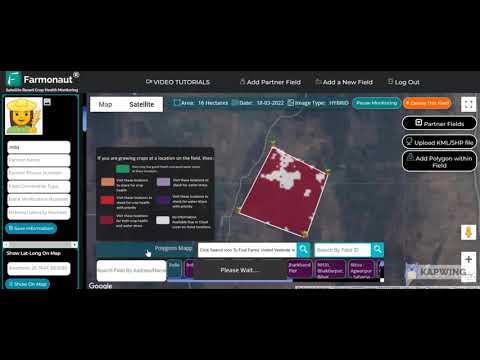Revolutionizing Local Food Systems: How Farmonaut’s Smart Farming Practices Boost Farm-to-Table Trends
“Local food sales in the U.S. reached $6.1 billion in 2020, with farmers markets growing by 180% since 2006.”
In the ever-evolving landscape of agriculture, we’re witnessing a remarkable transformation in how food is produced, distributed, and consumed. The rise of local food systems and sustainable agriculture practices is reshaping our relationship with what’s on our plates. At the forefront of this revolution are farm-to-table trends and direct-to-consumer sales, which are not just changing the way we eat but also how we think about our food and its journey from farm to fork.
In this comprehensive exploration, we’ll delve into the transformative power of local food systems and the innovative technologies driving this change. We’ll examine how companies like Farmonaut are leveraging cutting-edge agricultural technology to support smart farming practices, enhancing both productivity and sustainability in the process.

The Rise of Local Food Systems
Local food systems have gained significant traction in recent years, driven by a growing consumer desire for fresher, more sustainable food options. These systems prioritize short supply chains, connecting local producers directly with consumers through various outlets such as farmers markets, community-supported agriculture (CSA) programs, and direct farm sales.
- Increased freshness and nutritional value
- Reduced transportation costs and environmental impact
- Support for local economies and rural communities
- Enhanced food security and resilience
The growth of local food systems is not just a passing trend but a fundamental shift in how we approach food production and consumption. According to recent data, the market for local foods has expanded significantly, with sales reaching unprecedented levels.
Farm-to-Table Trends: A Closer Look
The farm-to-table movement epitomizes the essence of local food systems. This approach emphasizes serving locally-sourced ingredients at restaurants and homes, often with direct relationships between chefs or consumers and farmers. The benefits of this trend are multifaceted:
- Enhanced flavor and quality of ingredients
- Increased transparency in food sourcing
- Promotion of seasonal eating
- Support for local agricultural practices and economies
As farm-to-table trends continue to gain momentum, we’re seeing a ripple effect across the entire food industry, influencing everything from marketing strategies to supply chain management.
The Economic Impact of Local Foods
The shift towards local food systems has significant economic implications. Studies have shown that local food sales contribute substantially to local economies, creating jobs and fostering entrepreneurship in rural areas. Key economic benefits include:
- Increased local employment opportunities
- Higher local economic multipliers
- Diversification of local economies
- Improved financial performance for small and medium-sized farms
Moreover, the growth of farmers markets and other direct-to-consumer outlets has created new opportunities for farmers to capture a larger share of the food dollar, improving their financial performance and sustainability.
Consumer Preferences and Market Dynamics
Understanding consumer preferences is crucial in analyzing the growth of local food systems. Recent research indicates a strong and growing consumer interest in locally-produced foods, driven by factors such as:
- Perceived freshness and quality
- Support for local farmers and communities
- Environmental concerns
- Interest in food transparency and traceability
This shift in consumer preferences has led to changes in marketing strategies across the food industry, with even large conventional retailers increasing their offerings of local products.
“Farm-to-table trends have increased fruit and vegetable consumption by 24% among regular farmers market shoppers.”
The Role of Farmers Markets
Farmers markets have played a pivotal role in the growth of local food systems. These markets provide a direct connection between producers and consumers, offering fresh, locally-grown produce and artisanal products. The benefits of farmers markets extend beyond mere commerce:
- Increased access to fresh fruit and vegetable
- Community building and social interaction
- Educational opportunities about food and agriculture
- Incubation of small food businesses
The growth of farmers markets has been nothing short of remarkable, with the number of markets in the United States more than quadrupling over the past two decades.
Innovative Agritech Solutions
The growth of local food systems has been significantly enhanced by the advent of innovative agricultural technology. Companies like Farmonaut are at the forefront of this revolution, offering cutting-edge solutions that support smart farming practices. These technologies include:
- Satellite-based crop monitoring
- AI-driven advisory systems
- Precision farming techniques
- Blockchain-based traceability solutions
By leveraging these technologies, farmers can optimize their crop management, improve yields, and enhance the overall sustainability of their operations.
Explore Farmonaut’s innovative solutions:
Precision Farming Techniques
Precision farming techniques are revolutionizing agriculture, allowing farmers to optimize their resource use and maximize yields. These techniques include:
- Variable rate technology for targeted application of inputs
- GPS-guided machinery for precise planting and harvesting
- Soil and crop sensors for real-time monitoring
- Drone technology for aerial crop assessment
By adopting these techniques, farmers can significantly improve their productivity while reducing their environmental impact, aligning perfectly with the goals of local food systems.

The Impact on Rural Communities
The growth of local food systems has had a profound impact on rural communities. By creating new economic opportunities and fostering connections between urban and rural areas, these systems are helping to revitalize rural economies. Key impacts include:
- Creation of new jobs in agriculture and related industries
- Increased rural entrepreneurship
- Preservation of farmland and rural landscapes
- Enhanced community cohesion and social capital
These effects are particularly important in the context of ongoing challenges facing rural areas, such as population decline and economic stagnation.
Challenges and Opportunities
While the growth of local food systems presents numerous opportunities, it also comes with challenges. These include:
- Scaling up production to meet growing demand
- Developing appropriate infrastructure for local distribution
- Ensuring food safety in decentralized systems
- Competing with the economies of scale of conventional agriculture
Addressing these challenges will require ongoing innovation, policy support, and collaboration across the food system.
The Role of Policy in Supporting Local Food Systems
Government policy plays a crucial role in shaping the development of local food systems. Key policy areas include:
- Land use regulations to protect farmland
- Support for farmers markets and other direct marketing channels
- Procurement policies favoring local foods in public institutions
- Grants and technical assistance for local food initiatives
Effective policies can help create an enabling environment for local food systems to thrive, supporting both producers and consumers.
Nutritional and Health Impacts
The growth of local food systems has significant implications for nutrition and public health. Studies have shown that increased access to fresh, local produce can lead to:
- Higher consumption of fruits and vegetables
- Improved dietary diversity
- Increased food literacy and cooking skills
- Potential reductions in diet-related chronic diseases
These health benefits underscore the importance of local food systems in addressing broader public health challenges.
Environmental Sustainability
Local food systems have the potential to significantly enhance environmental sustainability in agriculture. Key environmental benefits include:
- Reduced food miles and associated greenhouse gas emissions
- Preservation of biodiversity through diverse cropping systems
- Improved soil health through sustainable farming practices
- Reduced packaging and food waste
By supporting these environmentally-friendly practices, local food systems contribute to broader sustainability goals.
The Future of Local Food Systems
As we look to the future, the continued growth and evolution of local food systems seem certain. Key trends to watch include:
- Increased integration of technology in local food production and distribution
- Growing collaboration between local and regional food systems
- Development of innovative urban agriculture models
- Expansion of local food into new product categories
These trends suggest a dynamic and exciting future for local food systems, with ongoing opportunities for innovation and growth.
Comparison: Traditional vs. Local Food Systems
| Aspect | Traditional Food System | Local Food System | Impact on Sustainability |
|---|---|---|---|
| Number of intermediaries | Multiple (processors, distributors, retailers) | Few or none (direct farm-to-consumer) | Positive – Reduced energy use in transportation and storage |
| Average distance food travels | 1,500 miles or more | Less than 100 miles | Positive – Lower carbon footprint from transportation |
| Time from harvest to consumption | Several days to weeks | Same day to a few days | Positive – Less food waste, higher nutritional value |
| Consumer interaction with producers | Limited or none | Direct and frequent | Positive – Increased food literacy and connection to agriculture |
| Economic impact on local communities | Limited – profits often leave community | Significant – money circulates locally | Positive – Strengthens local economies and rural development |
| Variety of produce available | Limited to what travels and stores well | Wide variety of local and seasonal produce | Positive – Promotes biodiversity and seasonal eating |
| Use of precision farming techniques | Variable, often large-scale applications | Increasing, with focus on small-scale, targeted use | Positive – More efficient resource use, reduced environmental impact |
| Environmental footprint | Higher due to long-distance transport and industrial practices | Lower due to reduced transport and often more sustainable practices | Positive – Reduced overall environmental impact |
Farmonaut’s Role in Revolutionizing Local Food Systems
Farmonaut plays a crucial role in supporting the growth and sustainability of local food systems through its innovative agritech solutions. By providing farmers with advanced tools for crop management and monitoring, Farmonaut enables more efficient and sustainable agricultural practices. Key contributions include:
- Satellite-based crop health monitoring for optimized resource use
- AI-driven advisory systems for improved decision-making
- Blockchain-based traceability solutions for enhanced transparency
- Resource management tools for increased efficiency
These technologies empower farmers to produce high-quality, local food more efficiently and sustainably, aligning perfectly with the goals of farm-to-table movements and local food systems.
Explore Farmonaut’s API and developer resources:
Farmonaut API
API Developer Docs
Conclusion
The revolution in local food systems, supported by smart farming practices and innovative technologies, is reshaping the agricultural landscape. From boosting rural economies to enhancing environmental sustainability and improving public health, the impacts of this transformation are far-reaching and profound.
As we continue to navigate the challenges and opportunities presented by this shift, it’s clear that the future of food production and distribution will be increasingly local, sustainable, and technologically advanced. Companies like Farmonaut are at the forefront of this revolution, providing the tools and insights needed to make smart farming practices accessible and effective for farmers of all sizes.
By embracing these changes and continuing to innovate, we can create a more resilient, sustainable, and equitable food system that benefits producers, consumers, and the planet alike. The farm-to-table movement is more than just a trend – it’s a fundamental reimagining of our relationship with food, and it’s here to stay.
FAQ Section
Q: What are the main benefits of local food systems?
A: Local food systems offer numerous benefits, including fresher and more nutritious food, support for local economies, reduced environmental impact from transportation, and increased food security for communities.
Q: How do smart farming practices contribute to local food systems?
A: Smart farming practices, such as precision agriculture and satellite-based crop monitoring, help farmers optimize resource use, improve yields, and reduce environmental impact, making local food production more efficient and sustainable.
Q: What role do farmers markets play in local food systems?
A: Farmers markets are crucial to local food systems, providing direct-to-consumer sales channels for farmers, increasing access to fresh produce for consumers, and fostering community connections around food.
Q: How does Farmonaut support local food systems?
A: Farmonaut provides advanced agritech solutions that help farmers optimize their crop management, improve yields, and enhance sustainability. These tools support more efficient local food production and distribution.
Q: What are some challenges facing local food systems?
A: Challenges include scaling up production to meet demand, developing appropriate distribution infrastructure, ensuring food safety, and competing with the economies of scale of conventional agriculture.






